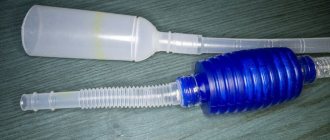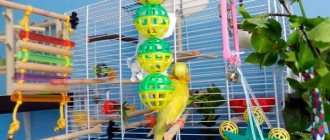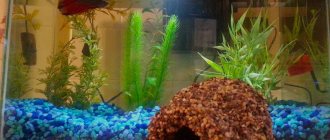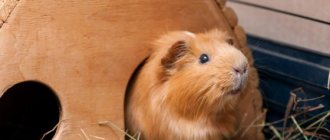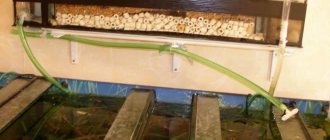Making a terrarium with your own hands
Before making a terrarium or aquarium, you must first calculate the dimensions of the turtle’s future home, then look at ready-made industrial or home-made models, take into account all the features (future location of the lamps, house, shore, pond, feeder, ventilation relative to each other and the turtle itself). Various materials are used to make terrariums: wood, glass, plexiglass, hard polyvinyl chloride, etc. Terrariums can be made framed or frameless. It is advisable to make large terrariums with frames, while small ones should be made entirely of glass or plexiglass. You can use old furniture for terrarium materials.
When making such glass terrariums, they are glued together using special adhesives. When using an unknown glue, be sure to read the instructions for use - the glue can be toxic to animals (this is especially important when assembling aquaterrariums).
Frameless plexiglass terrariums are glued using organic solvents (dichloroethane, chloroform) with the addition of plexiglass shavings to create your own glue. Frames for large terrariums, as the main supporting structure, are best made from metal corners and wooden blocks. Ribs and ties are not usually used for terrariums. Glass is selected with a thickness of 4-5 mm.
Ventilation is usually located in two places - in the lid of the terrarium, on the sides or under the front door. The ventilation mesh is usually made of rigid perforated aluminum sheet with 3mm holes. The size of the top ventilation is approximately 1/3 of the total width of the terrarium. The size of the bottom ventilation made in the form of a “pocket” (the width of the mesh fabric) is from 20 to 50 mm, depending on the size of the terrarium. The incandescent lamp must be hung at a height of at least 25 cm from the turtle, so the height of the terrarium should be at least 40 cm, preferably 45-50 depending on the type of lamps used. Regardless of the material used, it is necessary to carefully paint the structure to protect it from moisture. For wooden elements, good results are obtained by double treatment with hot drying oil followed by coating with furniture varnish. If the preservation of the natural color and texture of the wood is important, then various epoxy paints with rich and bright colors can be used to cover the frame elements with high reliability. Metal structures (both steel and duralumin) must be painted on all sides. Here epoxy paints are even more effective. The ceiling, floor and walls in large terrariums can be made of multi-layer plywood. Its processing is the same as for power wooden frame structures. It is possible to cover the floor with thin plastic or linoleum. Such coatings are reliable, but it is important that water cannot get through the cracks under the coating, since this creates conditions extremely favorable for the destruction of both wood and metal. Therefore, when using sheet coating materials, special attention must be paid to the integrity of the sheet, processing and sealing of joints. When selecting materials for building terrariums, it is necessary to take into account that some of them begin to release toxic substances over time (especially at elevated temperatures). It is necessary to strive to ensure that terrariums, in their design and technical equipment, are close to a climate chamber, where you can change the temperature, light and humidity conditions at will, regardless of external conditions. There are different methods for securing the terrarium door:
1. The runners are from the bookshelf (a furniture groove with an H section), then the glass door will move to the side. Often they even install 2 glasses, not just one. First you need to cut two strips of glass (see picture). The width of one (3) is a third of the total height of the terrarium, the other (1) is 10-15 centimeters. The thickness of the glass should be approximately 4 millimeters. The length of both strips is equal to the length of the front panel of the terrarium. The first strip is glued down, the second - up, on the ends of the side, top and bottom windows. Grooves (4) are put on them, which are slightly shorter than these strips. Divide the difference between the length of the front panel and the length of the groove by two - this will be the width of two more strips of glass (2), which are glued from behind to the top and bottom strips. All that remains is to cut out the glass for the door. If it seems too big to you, it may make sense to cut it into two halves - sometimes this is more convenient. (Aquarium Magazine 1997 No. 1)
2. Glass holders, then the glass will be pulled out towards itself;
3. Door fastening with magnets. But here it should be taken into account that a turtle can knock down such a door, and in a damp terrarium the magnet can rust if it is glued inside.
If you understand that you cannot handle making an aquarium or terrarium yourself, then you can order it from aquarium and terrarium companies. How to make a removable partition in a terrarium? There are several ways to make a removable partition in a turtle terrarium. For example, two strips of glass are glued to the bottom with sealant, the distance between them is equal to the width of the glass. Their height is about 4 cm; thick glass is inserted between them, sealed with a background. You can also make a partition from ordinary waterproof plywood in the shape of the letter T. You can use plastic runners for glass from bookshelves, but glue them on the sides, not the bottom. Photos of the partition:
You can also read about making a terrarium here: https://myreptile.ru/forum/index.php?topic=735.0
How to make and decorate a terrarium for a red-eared turtle: drawings, description, photo
The lizard suborder includes all squamates except snakes. This includes:
- Iguanas;
- Chameleons;
- Geckos;
- Agamas.
We suggest you read: Barbs compatibility with other fish in the aquarium
Snakes are descendants of lizards and are classified as a separate suborder. Many people keep various lizards as pets. Many people also keep snakes at home. To keep these pets, it is necessary to have a terrarium suitable for the conditions. There are a lot of varieties of lizards and snakes. Some of them live in trees, others live in the ground. Therefore, before getting a certain type of pet, it is imperative to familiarize yourself with the conditions suitable for a particular pet.
Terrariums for scaly animals come in the following configurations:
- Horizontal - for reptiles leading an amphibious lifestyle (snakes, snakes).
- Vertical - for arboreal lizards and reptiles living in mountainous areas (chameleon, iguana).
- Cubic - for those living in the thickness of the earth, in burrows (gecko, typical lizards).
To make terrariums with your own hands, ordinary or organic glass is used. Ordinary glass is inferior in its characteristics to organic glass, since it is more fragile. For large animals, it is recommended to make terrariums with a frame made of wood or metal. The plexiglass sheets are glued together with silicone glue.
A terrarium for reptiles must be equipped with UV lamps, ventilation, and must be closed with a lid so that the animal does not escape. Thermal mats are used as heating; they are placed under the ground.
For chameleons and iguanas, it is necessary to organize a tropical terrarium. There is little space for water here. But you need branches for climbing. The presence of rough surfaces is welcome, as this provides additional climbing opportunities.
Terrarium for chameleon
For typical lizards, it is also necessary to have branches for climbing. If the lizard likes to burrow into the soil, the thickness of the sand should be at least 10 cm.
A desert terrarium should be organized for the agama. Calcium sand is used as soil. The temperature should be maintained within 30°C. A thermometer is installed for adjustment. In a desert terrarium, be sure to place a small container of water.
Desert terrarium for agama, lizards
An aquaterrarium for snakes and snakes must be equipped with water and dry land. On land, it is necessary to have a house for shelter. These animals are demanding of water; its temperature must always be within 20°C.
The presence of plants in the terrarium is mandatory. This is not only decor, but also a source of food and oxygen. The following plants are suitable for exotic animals:
- Moss
- Fern
- Ficus tiny
- Ivy
Terrariums for snakes and lizards should have high humidity.
The plant terrarium is called florarium. You can grow plants in a bottle or jar. This flower arrangement takes up very little space, but looks impressive.
Growing plants in a jar or bottle is similar to growing plants in a greenhouse. The presence of container walls allows you to maintain the necessary microclimate of the florarium. Jars with plants are covered with lids or a small hole is left.
The disadvantage of growing plants in a jar is the difficulty of care. Cleaning a florarium and getting rid of dead plants can be quite troublesome. But, nevertheless, this does not stop connoisseurs of florariums.
For the florarium, you can use both glass and plastic bottles. Plastic containers are inferior to glass ones in their characteristics and appearance. The container does not have to be in the form of a jar. These can be vases, serving caps, large glasses, etc.
In addition to evergreen exotic plants, you can grow a single flowering plant in a jar. Recently, it has become fashionable to give such flower arrangements. The advantage of such a gift is its durability. You can, of course, give a flower in a pot, but a florarium looks more impressive and stylish.
Florariums are used to decorate home and office interiors. A row or series of florariums looks original. The process of planting plants in a jar or bottle is essentially no different from planting plants in an aquarium. However, planting plants in a container with a narrow neck is painstaking work.
How to plant plants in a bottle or jar:
- First, layers are poured in the same order as in the aquarium: pebbles, moss, soil.
- Use a long narrow stick to make indentations.
- Carefully remove the plants, along with their roots, from the pots in which they were sold.
- Using two long sticks, place the plants into the holes.
Caring for the terrarium is not difficult: just water the plants as the soil dries out, and also wipe off the dust from the jar inside and out. If there are no problems with wiping dust from the outside, then many may be puzzled - how to wipe the dust inside the terrarium? This is not difficult: you can wrap a piece of soft sponge on a flexible wire, which will simply cope with dirt. A soft-bristled toothbrush will also work if it is the right size for your terrarium.
Florarium
How to make and decorate a terrarium for a tarantula spider, ants, Madagascar cockroaches, and a praying mantis?
Insect terrariums must also have a number of certain characteristics. If everything is done correctly, the life of insects will be comfortable and safe.
We suggest you read: What to do if a cat is limping on a front or back leg. The cat is limping on his front paw what to do The cat is limping on his front paw what to do
Let's look at how to set up terrariums for various insects.
Terrarium for tarantula spider:
- Keeping a tarantula spider at home requires a spacious terrarium. There should be no objects with great height inside to prevent the tarantula from falling.
- Provide shelter. Pieces of bark, flower pots and other similar devices are suitable for this.
- It is not recommended to place stones in the tarantula spider's terrarium, as the insect may be injured.
- The size of the terrarium is calculated as follows: the length of the spider’s legs is multiplied by two. For example, the length of the legs of an adult spider is 14 cm.
- In this case, the size of the “house” should be 30x30x20 cm. Moreover, 20 cm is a safe height for a tarantula spider.
- Be sure to make holes on the sides and top for ventilation.
- The bottom is covered with soil, and branches are placed for tree spiders.
Terrarium for a tarantula
Terrarium for a praying mantis:
- A vertical terrarium is suitable for the praying mantis.
- Pour soil into the bottom and place a layer of foliage on top. If the foliage is large, additional cover is not required.
- Humidity should not be too high; spraying is not recommended frequently.
- The temperature in the terrarium is 25°C.
- The terrarium should not be placed in direct sunlight.
- Ventilation is required.
Contents of the praying mantis
terrarium for ants:
- To keep unusual pets, a narrow flat container is required.
- Sometimes 2 jars are used to maintain an ant farm, so that one fits into the other. Both jars are closed with lids. An ant family is located in the space between the banks.
- A terrarium for ants is called a formicarium. Sand or a special gel containing additives for ants is poured inside.
- Some people collect ants in the forest and collect soil there.
Formicarium
Terrarium for Madagascar cockroaches:
- If the terrarium for Madagascar cockroaches is not equipped with a lid, then lubricate its walls with Vaseline so that the insects do not escape. It is better to cover the home of Madagascar cockroaches with a lid with holes.
- There must be a lot of hiding places inside. To do this, they use egg trays; cockroaches love them for the presence of cells, toilet paper rolls, pot fragments, and wood.
- The flooring should be made of fragrant wood with sand. The wood is preferably coniferous, it is changed periodically.
Keeping Madagascar cockroaches
How to make and decorate a terrarium for Achatina snails?
Achatina snails are large sized mollusks. It’s easy to keep them, because these snails are undemanding to conditions. Even in the temporary absence of the owner, they can feel good if taken care of in advance.
A terrarium for Achatina snails can be made of regular or plexiglass, or you can use a plastic container. The “house” for snails should have small holes for ventilation. It must be of such a size that the snail does not escape.
Container equipment requirements:
- Cover the bottom with flower substrate without fertilizers; snails love to burrow into the soil. Suitable substrates include sand, walnut shells, and coconut shells. The bad layer is clay and tree bark.
- The soil should always be moist, but not waterlogged. The soil is sprayed with a spray bottle daily.
- There is no need to install lighting lamps for snails. Soft, diffused daylight suits them. During the day, snails hide in the substrate and are awake at night.
- The air temperature in the container should be about 24°C.
To cover Achatina snails, fragments of flower pots, coconut shells, and stones are placed inside the container. Also, living plants are planted in the substrate: moss, ivy, fern, lettuce, cereals, etc.
Terrarium for Achatina snails: top view





